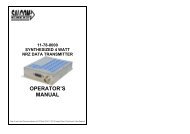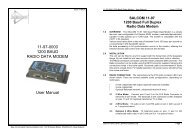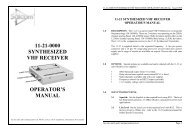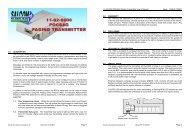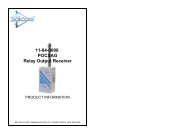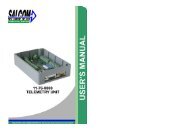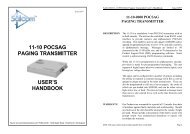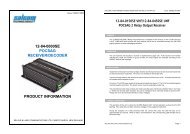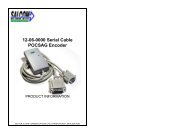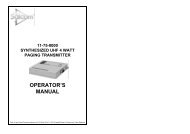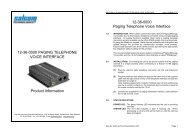MRB406 EPIRB OPERATORS HANDBOOK - Salcom
MRB406 EPIRB OPERATORS HANDBOOK - Salcom
MRB406 EPIRB OPERATORS HANDBOOK - Salcom
You also want an ePaper? Increase the reach of your titles
YUMPU automatically turns print PDFs into web optimized ePapers that Google loves.
SALCOM <strong>MRB406</strong> Operator’s Handbook 1180UC 0208<strong>MRB406</strong> <strong>EPIRB</strong><strong>OPERATORS</strong> <strong>HANDBOOK</strong>DESCRIPTIONThe SALCOM <strong>MRB406</strong> operates on 406MHz and meets the international specification required by<strong>EPIRB</strong>s utilizing this satellite system. As from February 2009 only <strong>EPIRB</strong>s transmitting on406MHz will be monitored by satellite. When activated, the 406MHz transmitter sends a uniqueidentification number which, if the unit is registered, can be utilized by search and rescueauthorities to provide owner details which can contribute to the effectiveness of a rescue operation.The <strong>MRB406</strong> also transmits on 121.5MHz and is used for homing purposes by search aircraft. Thebeacon also has a solid state strobe which emits a high intensity flash to assist in location.Because the <strong>MRB406</strong> uses the same mounting bracket as the previous MRB4 <strong>EPIRB</strong> it is aconvenient direct replacement. It is capable of manual or automatic operation. When releasedfrom its bracket and aerial restraint, the <strong>MRB406</strong> will automatically activate when placed in water.SEQUENCE OF EVENTS UPON ACTIVATIONWhen activated, either by manual switch-on or automatic activation by immersion in water, thewhite strobe indicator gives one flash and pulses at ten second intervals for one minute.DURING THIS FIRST MINUTE NO ALARM SIGNALS ARE BEING SENT.After one minute the following actions take place simultaneously:(1) The 121.5Mhz homing transmitter starts transmitting and approximately 50 seconds later isinterrupted briefly when the 406Mhz transmitter sends a burst containing <strong>EPIRB</strong> identification.(2) The white strobe indicator begins flashing at a faster rate (approximately every 2.3 seconds).(3) The red led indicator flashes indicating transmissions are taking place.(4) An audible sound may be heard which is the sound of the homing transmitter siren operating.The 406Mhz signal may be detected instantly by Geo-stationary satellites which are in equatorialorbits but the actual calculation for position information can only be obtained by LEO (Low EarthOrbit) satellites which regularly cover every area of the globe.THE IDENTIFICATION CODE:The <strong>MRB406</strong> is factory coded with a unique serial number and model identification.This number ismatched to the registration data by Search & Rescue authorities to identify the owner. It istherefore important that the form enclosed with this manual is returned to your nearest SARauthority. The <strong>MRB406</strong> may also be coded with ships identification number MMSI or radio callsign.The registry for these protocols enables SAR authorities to directly identify your vessel. MMSI andradio callsigns can only be programmed into the <strong>MRB406</strong> by the Manufacturer or his authorisedrepresentative.REMEMBER THAT IF THE UNIT HAS BEEN ACCIDENTALLY ACTIVATED YOU HAVE A PERIOD OFONE MINUTE BEFORE AN ALARM IS SENT DURING WHICH YOU CAN SWITCH IT OFF.Sea Air & Land Communications Ltd Page 2
SALCOM <strong>MRB406</strong> Operator’s Handbook 1180UC 0208SALCOM <strong>MRB406</strong> Operator’s Handbook 1180UC 0208TEST SWITCHA separate “Test” switch is mounted on the <strong>EPIRB</strong>.A test should be performed approximately once a month to verify the <strong>EPIRB</strong> is in working order.To start a test, press and hold the switch for 2 seconds (the red light will illuminate). If possible,limit this test to the first 5 minutes of each hour to minimize interference. After about 2 seconds,during which a brief siren burst should be heard, the strobe light will give one flash indicating asuccessful test.If the battery voltage is low , or the transmitter output is low or fails, the strobe light will not flash.Instead the test failure is indicated by the red LED indicator flashing rapidly for a further fiveseconds before the <strong>EPIRB</strong> automatically shuts down. Holding the “Test” switch continuously downwill only result in the one test transmission sequence.HOW TO STORE AND ACTIVATE YOUR <strong>EPIRB</strong>1. Ensure that the aerial is folded and held by the plastic breakaway seal. The aerial mustremain folded at all times to help prevent accidental activation and prove that the <strong>EPIRB</strong> hasnot been tampered with. If the aerial is raised and the <strong>EPIRB</strong> is wet, the presence of wateracross the outside terminals could activate the <strong>EPIRB</strong>.2. Secure the bracket VERTICALLY to a suitable bulkhead in a elevated position that allowseasy access away from exposure to water or fuel fluids. Ensure there is no possibility ofdamage by falling objects or personnel. Keep the <strong>EPIRB</strong> clean and well maintained.Do not mount it closer than 300mm (1 foot) to navigation devices such as compasses. The<strong>EPIRB</strong> should not be mounted close to strong magnetic fields such as radar equipment.Ensure that unauthorized persons or children are always supervised to prevent tampering.3. At regular intervals (recommend monthly) press the “TEST” button firmly whilst the <strong>EPIRB</strong> ismounted in the bracket as noted in the “Test Switch” section above.4. In an EMERGENCY SITUATION(1) Remove the <strong>EPIRB</strong> from the quick-release bracket.(2) Unwrap any restraining tape on the aerial, and lift the aerial to the vertical position,thereby breaking the plastic seal.(3) Unravel the attached securing line and switch the <strong>EPIRB</strong> “ON” using the toggle switchwhich is exposed when the aerial is raised.If conditions allow, the <strong>EPIRB</strong> operates most effectively if it is placed in the water. Ensure thatit is firmly attached by the lanyard. With the aerial raised, it will begin operating regardless ofthe position of the operating switch and will transmit for a minimum period of 48 hours.5. SWITCHING OFF: In an emergency, once activated, the <strong>EPIRB</strong> should be left operating untilyou have been rescued or you have been requested to switch it off. If the <strong>EPIRB</strong> fails toswitch off by the operating switch then the water level contacts may be conducting.Dry the <strong>EPIRB</strong> if possible and fold the aerial to its original position, securing with either tapeor cord. In the folded position the <strong>EPIRB</strong> should stop transmitting (provided the operatingswitch is also “OFF”). Should the <strong>EPIRB</strong> continue to transmit, disconnect the battery plug byunscrewing the four case retaining screws and removing the top case.6. ALTERNATIVE OPERATING SITUATIONS: Metal enclosures may screen and degrade thequality of transmission and the <strong>EPIRB</strong> should be located away from such situations. It isrecommended that an open area clear of such obstructions as liferaft canopies, deck sheltersetc., be sought.7. ACCIDENTAL ACTIVATION: It is important that precautions are taken to prevent accidentalactivation that may alert Search and Rescue authorities. Pressing the “Test” button will notalert the authorities. Keep the <strong>EPIRB</strong> in a secure situation where it can not easily be activatedaccidentally and do not allow unsupervised access by children or others. If the <strong>MRB406</strong>starts flashing at 10 second intervals it means that it is about to transmit an alarm signal. If anaccidental alarm signal is transmitted (the siren will be heard and the strobe light will flashevery 2 seconds) you should disable it immediately. Advise the nearest Search and RescueCentre of the date ,time, duration, the HEX code (as printed on the <strong>EPIRB</strong>) and the reason forthe accidental activation. Familiarize yourself with the operation of the <strong>EPIRB</strong> before anemergency develops.BATTERY REPLACEMENTThe batteries fitted to the <strong>MRB406</strong> are long life Lithium type cells. Batteries will be required to bereplaced within five years of purchase. The expiry date is marked on the outside case and theinternal battery pack indicating when the batteries should be replaced. Only authorized dealers andcertified technicians should carry out battery pack replacement.If the <strong>EPIRB</strong> has been used in an emergency ensure that it is serviced and the battery packreplaced. Used battery packs must be discarded through a hazards disposal organization.TRANSPORTATIONDevices containing Lithium batteries have certain transport restrictions placed upon them. Do notuse the postal service but check with your courier Company before dispatch.REGISTERING YOUR <strong>EPIRB</strong>It is very important that the enclosed Registration Form is completed and forwarded to theAuthorities shown. This information is essential to allow a match of your <strong>EPIRB</strong> with your vesseldetails once the <strong>EPIRB</strong> identification number is received.Enclosed with this <strong>EPIRB</strong> are registration papers appropriate to the Country of purchase and whichyou should complete and forward to the address shown. You should note the following:Sea Air & Land Communications Ltd Page 3Sea Air & Land Communications Ltd Page 4
SALCOM <strong>MRB406</strong> Operator’s Handbook 1180UC 0208SALCOM <strong>MRB406</strong> Operator’s Handbook 1180UC 0208(1) The Country of Registration (i.e., Country Code as marked on the outside of the <strong>EPIRB</strong>)should match your country of residence and contact numbers.(2) If you are purchasing an <strong>EPIRB</strong> and your address is outside the country of purchase the<strong>EPIRB</strong> should be reprogrammed by your supplier. Normally the country code will be the sameas the country in which you have purchased your <strong>EPIRB</strong>.(3) If you should sell or dispose of your vessel and/or <strong>EPIRB</strong> you should ensure that the newdetails are also forwarded to the appropriate authority.Keep the original packing for shipping and service.CroatiaFijiHarbour Masters Offica51000 RijekaSenjsko Pristaniste 3, CroatiaCoding, Registration and Type Approval(ELTs):Air Safety DepartmentCivil Aviation Authorityof Fiji IslandsPrivate Mail BagNadi Airport, Fiji Islands(385.51) 214031(385.51) 212474(385.51) 212696(385.51) 212660(679) 721555 (679) 725125sao@caaf.org.fjPRINCIPLE CONTACT NUMBERSA short list of Search and Rescue Authorities addresses follows. For full details a comprehensivelist may be obtained from the cospas/sarsat web site at www.cospas-sarsat.org under “beacons”,“beacon registration”.Country Name & Address Telephone Telex Fax/emailArgentina National Maritime,Fluvial and Lacustre SAR AgencyBase Naval Puerto Belgrano (CP811)Buenos Aires, Republic of Argentina(54.1) 317 2038(54.0) 093287140(54.0) 093287150(33) 9085SICO AR(54.0) 093287153FranceCoding / Registration:Regulatory Administration / MaritimeMinistère de la Mer / SECMAR3 Square Desaix, 75015 Paris, FranceGreece Coding / Registration / Type Approval /Licensing:Hellenic Ministryof Merchant MarineMerchant Ships InspectorateRadiocommunication Department1 K.Palaiologou StreetGR-185 35 Piraeus, Greece(33.1) 44371643 201052MISMER F(30.1) 419 1817(30.1) 419 11815(60.1)212581EEPGR(33.1) 40581050(30.1) 4137997telecoms@mail.yen.grAustraliaBahamasBrazilCanadaRegistration and Coding:Planning & Business Support ManagerEmergency ResponseAustralian Maritime Safety AuthorityLevel 3, 25 Constitution AvenueGPO Box 2181 Canberra City, ACT, 2601AUSTRALIACoding, Registration and Type Approval:4th TerraceCollins AvenueP.O. Box N-48601Nassau, BahamasCINDACTA1 / BRMCCSHIS QI 05 Lago Sul - Area Especial 12CEP- 71615-600, Brasilia - DF, BrazilRegistration (<strong>EPIRB</strong>s/ELTs, PLBs):Canadian Beacon RegistryNational Search and Rescue Secretariat275 Slater Street, 4th FloorOttawa, Ontario K1A 0K2Canada(61.2)62795711 (71) 62349MRCCAUSAA62349(61.2) 62306868rccaus@ausa.gov.au(1.242) 322 4437 (1.441) 323 7288egmoss@pucbahamas.gov.bs(55.61) 3658395 (55.61) 3652964brmcc@cindacta1.aer.mil.br(1.613) 996 1504(1.800) 727 9414(Canada only)(1.613) 996 3746Ireland(Republic of)ItalyMalaysiaNew ZealandRegistration (<strong>EPIRB</strong>s):Maritime Radio Affairs Unit(353.1) 619 9280Room 328, Department of(353.1) 619 9281Communications and Natural ResourcesLeeson Lane, Dublin 2Republic of IrelandITMCCLungomare Staritan.5 - 70123Bari, ItalyMarine Department Peninsular MalaysiaSafety of Navigation DivisionP.O.Box 12, 42007 Port Klang, MalaysiaNew Zealand Rescue CoordinationCentreAvalon TowerPercy Cameron StreetPO Box 30050Lower Hutt, New Zealand(39.080) 534 1571(39.080) 534 4033(353.1) 662 1571john.byrne@marine.gov.ie811376 (39.080) 534 2145itmcc247@infinito.it(60.3) 368 6616 (60.3) 367 1334(60.3) 368 5020kpgr@marine.gov.my(64.4) 9148391 (64.4) 9148383www.406registry@msa.govt.nzChileCoding / Registration:RegulatoryAdministration / MaritimeDireccion General del TerritorioMaritimo y de Marina Mercante /DGTM y MMErrazuriz 537Valparaiso, Chile(56.32) 208281(56.32) 208283(56.32) 208284230602DGTM CL330461DGTM CK330607ANGEL CK(56.32) 208042SingaporePort Operation ControlMaritime and PortAuthority of Singapore21st Storey, Tanjong Pagar Complex7B Keppel RoadSingapore 089055Republic of Singapore(65) 6226 5539 (87)MARTEL RS20021(65) 6227 9971pocc@mpa.gov.sgSea Air & Land Communications Ltd Page 5Sea Air & Land Communications Ltd Page 6
SALCOM <strong>MRB406</strong> Operator’s Handbook 1180UC 0208SALCOM <strong>MRB406</strong> Operator’s Handbook 1180UC 0208SouthAfricaSpainSwitzerlandUnitedKingdomRegistration (<strong>EPIRB</strong>s):SASARMRCC Cape TownPrivate Bag X8, Tokai 7966, SouthAfricaCoding / Registration (<strong>EPIRB</strong>s):Area de Inspección RadiomaritimaDirección General de laMarina MercanteCalle Ruis de Alracón, 128071 Madrid, SpainRegistration (<strong>EPIRB</strong>s):Schweizerisches SeeschiffahrtsamtNauenstrasse 49PostfachCH-4002 Basel, SwitzerlandCoding / Registration (<strong>EPIRB</strong>s):HM CoastguardPendennis Point, Castle DriveFalmouth, CornwallTR11 4WZ, UK(27.21) 787 2222 (27.21) 787 2337(34.91) 597 9275 (34.91) 597 9176jaalonso@mfom.es(41.61) 270 91 26 (41.61) 270 91 29(44.1326) 211 569 (44.1326) 319 264IndicatorsHigh intensity white light >0.75cd: indicates successful test with one flashas well as slow and fast flashes upon activation.(10secs & approximately 2.3secs.)Red Led: Indicates transmissions are taking place and also operates as afail and fault indicator;Slow flash: normal transmission is taking place.Fast flash: a fault has developed such as Low battery or Low power transmit.Internal SpeakerAudible indicator of Homing transmitter siren.Lanyard length min. 5M.Transmit frequencies406.028Mhz and 121.5Mhz.Transmit power 406mhz 5 watts +/- 2db modulation PSKTransmit power 121.5Mhz 75mW +/- 3db, modulation AM >85% downward swept tone.Compass Safe DistanceBattery SupplyFormatSecurityBracket;300mm (12 inches) from any navigational device.Nominal 9 volts from 3 X D Lithium cells.(type LO26SX)Battery expiry; Within 5 years. Marked on outside case and also on internalcell holder.<strong>MRB406</strong>: User Protocol, serial number. (short message)MMSI or Radio Callsign programmableBreak-away antenna tabVertical mount, quick-releaseHOW THE COSPAS/SARSAT SATELLITE SYSTEM WORKSUnited StatesofAmericaCoding / Registration:Sarsat Beacon RegistrationE/SP3, RM 3320, FB-4NOAA5200 Auth RoadSuitland, MD 20746-4304USA<strong>MRB406</strong> SPECIFICATIONS(1.301) 457 5678 (230)7407681SARS UC(1.301) 568 8649ClassificationClass II, manual deployment, manual or water activated.Operating temp range -20degs C to +55degs C.Storage -30 to +70 deg. C.ReflectorSolas retro-reflective above waterline.Weight<strong>MRB406</strong>, 1050gms,Dimensions345x80x80mmBracketQuick- release toggle.EnduranceMinimum 48 Hours.SecurityBreakable plastic seal.Certification Cospas-sarsat t.001,t.007. AS/NZS 4280:1:2003ActivationRaise aerial: Transmission is automatic by immersion in water or manualswitch activation after a min period of 1 minute.Test: Momentary (separate) switchone transmission per press.ProcessingInternal processing of digital and r.f. levels of both transmitters.The world body known as the Cospas/Sarsat organization is charged with running a global satellitesystem for Search and Rescue purposes. The system has been running for many years and isregularly upgraded with the launching of new satellites and new or enhanced Ground Receivingstations known as Local User Terminals (LUT’s).The system covers the entire globe so that it is possible to be located on any surface area of theearth. A number of polar orbiting satellites (referred to as Low Earth Orbit {LEO} satellites) receive406Mhz signals and, until 2009, 121.5Mhz signals. By measuring their Doppler (or frequency shift)they are able to determine the position of the distress call. The 406Mhz signals carry identificationdata which can be matched to a register. Once processed at the LUT the identity and position areused to instigate a rescue operation. Polar orbiting satellites must be in sight of both the distressbeacon and a LUT station for near instantaneous alarm. If these conditions cannot be met then thereceived satellite 406Mhz information is stored and sequentially downloaded so that eventually aLUT in range will receive the message. This means that there are possible delays in some areas ofthe world before the message can be acted upon - sometimes 30 minutes or more as satellitescome within range.To overcome this situation there are now several satellites stationed in Geo-stationary orbits at theequator which means they are effectively stationary over certain areas of the world. This givesthem enormous Line Of Sight (LOS) capability to latitudes around 55degrees north and south.Signals on 406Mhz are received and processed in near real time under these circumstances.Because they are effectively stationary, these satellites cannot determine the position of the <strong>EPIRB</strong>unless the <strong>EPIRB</strong> transmits its actual position. Thus GPS equipped <strong>EPIRB</strong>’s are likely to beresponded to quicker than a non-gps model although it must be emphasized that the combinationof LEO and Geo-stationary satellites will result in improved response even if a Location is notreceived.Sea Air & Land Communications Ltd Page 7Sea Air & Land Communications Ltd Page 8
SALCOM <strong>MRB406</strong> Operator’s Handbook 1180UC 0208SALCOM <strong>MRB406</strong> Operator’s Handbook 1180UC 0208121.5Mhz Homing Transmitter: This transmitter assists in the final location of a distress call bysearch aircraft or vessels. Suitably equipped craft may use radio direction finding equipment whenclose to the position for final location. The frequency is an International Aircraft Distress channeland thus it may also be heard by any aircraft within range. Up to February, 2009 this frequency isalso monitored by the LEO satellite system. Its range is not totally global because it is strictly aLine of Sight system where the Satellite, <strong>EPIRB</strong>, and Ground Station (LUT) must all be withinrange of each other.LEOSAR CoverageThe Cospas-Sarsat LEOSAR system provides global coverage for 406 MHz beacons, andcoverage over most land areas for 121.5 MHz beacons. The shaded areas in the map overleafindicate regions without coverage for 121.5 MHz beacons.<strong>EPIRB</strong> Purchase or Transfer.Registration of 406 MHz satellite <strong>EPIRB</strong>s with the <strong>EPIRB</strong> Registration Section of the national authority is mandatory because ofthe global alerting nature of the COSPASSARSAT system.The information provided in the registration is used only for search and rescue purposes.Fill in the owner registration card immediately upon completion of the sales transaction. Mail, fax or email the registration cardto the national authority immediately-Registration cards are also available on line.Australian Registration<strong>EPIRB</strong> Regisgtration Section,AuSSARAustralian Maritime Safety Authority (AMSA)Reply Paid No. 81GPO Box 2181,CANBERRA ACT 2601fax: 61 02 6230 6868Email;aus_beacon_query@amsa.gov.auNew Zealand RegistrationRescue Co-ordination Centre,Civil Aviation Authority of New ZealandP.O. Box 31441LOWER HUTTFax; 64 4 566 2525email; 406registry@caa.govt.nzIf the beacon is to enter service immediately, complete the registration card and fax or email the information to the relevantnational authority.If the beacon is being transferred to a new owner, the current owner is to inform the national authority by email, facsimile, letteror telephone of the name and address of the new owner.The new owner of the beacon is required to provide the national authority with the information as shown on the registration card.This obligation transfers to all subsequent owners.1 ALGIERS, ALGERIA 16 HONG KONG, CHINA 31 ARKHANGELSK, RUSSIA2 OUARGLA, ALGERIA 17 TOULOUSE, FRANCE 32 NAKHODKA, RUSSIA3 PARANA, ARGENTINA 18 BANGALORE, INDIA 33 JEDDAH, SAUDI ARABIA4 RIO GRANDE, ARGENTINA 19 LUCKNOW, INDIA 34 SINGAPORE5 ALBANY, AUSTRALIA 20 JAKARTA, INDONESIA 35 CAPE TOWN, SOUTH AFRICA6 BUNDABERG, AUSTRALIA 21 BARI, ITALY 36 MASPALOMAS, SPAIN7 BRASILIA, BRAZIL 22 KEELUNG, ITDC 37 BANGKOK, THAILAND8 RECIFE, BRAZIL 23 YOKOHAMA, JAPAN 38 COMBE MARTIN, UK9 CHURCHILL, CANADA 24 DAEJEON, KOREA 39 ALASKA, USA10 EDMONTON, CANADA 25 WELLINGTON, NEW ZEALAND 40 CALIFORNIA, USA11 GOOSE BAY, CANADA 26 ABUJA, NIGERIA 41 FLORIDA, USA12 EASTER ISLAND, CHILE 27 TROMSOE, NORWAY 42 GUAM13 PUNTA ARENAS, CHILE 28 SPITSBERGEN, NORWAY 43 HAWAII, USA14 SANTIAGO, CHILE 29 LAHORE, PAKISTAN 44 HAIPHONG, VIETNAM15 BEIJING, CHINA 30 CALLAO, PERUSea Air & Land Communications Ltd Page 9Sea Air & Land Communications Ltd Page 10
SALCOM <strong>MRB406</strong> Operator’s Handbook 1180UC 0208SALCOM <strong>MRB406</strong> Operator’s Handbook 1180UC 0208WARRANTYYour "MRB4" beacon is guaranteed for a period of 5 years from date of purchase against faulty ordefective materials or workmanship. During this period, repairs or replacement, at themanufacturers discretion, will be made without charge, providing that the beacon has not beensubjected to dismantling, abuse, or mishandling. The period of 5 years will be extended for afurther 5 years if the beacon is returned to the company or authorised representative within theprescribed 5 years for battery and service check. Beacons requiring service or repair should besent freight pre- paid direct to the manufacturer or his authorised representative. No responsibilityis given or implied by the manufacturer as to the effectiveness of any beacon as the operation ofany such beacon is outside the control of the manufacturer.LIST OF DISTRIBUTORSTO BE ADVISED.Geo-Stationary Satellite positions and coverage to Latitudes approximately 60 degrees N/S.A POINT TO REMEMBERWhen considering what emergency equipment you should carry on your vessel it is important torecognize that an <strong>EPIRB</strong> is your last means of summoning assistance. It as Emergency device thatshould only be used when you or some personal are in “Grave And Imminent Danger”. This meansthat prior to activation on your <strong>EPIRB</strong> you have used whatever other communications equipmentthat is available to call for assistance.SERVICING AND MAINTENANCEAs with all safety equipment ensure that your <strong>EPIRB</strong> is well maintained and not subjected topotentially damaging situations. Keep it clean from build up from salt, grime and oil. – your life maydepend upon it!Check its operation approximately once per month by pressing the “Test” button and ensure thatthere is one bright flash indicating satisfactory performance occurs. Check that the battery expirydate is current. If you <strong>EPIRB</strong> requires service or battery replacement you should return it to thesource of Distribution or alternatively direct to the Manufacturer.Contact the manufacturer for advice and your nearest service centre. All freight must be pre-payedby the sender and you must advise your carrier that the <strong>EPIRB</strong> contains Lithium batteries.Sea Air & Land Communications Ltd Page 11Sea Air & Land Communications Ltd Page 12



